
 High-frequency valves
High-frequency valves
You won't find these in your old radio! Due to the special physical requirements of high-frequency operation, these devices look very different from conventional valve types.

 High-power RF triode, forced-air cooled
(5" high)
High-power RF triode, forced-air cooled
(5" high)
> General Electric 2C46
From Dennis Davis : The GE 2C46 appears to be what we called a
lighthouse tube. Such were used in the US Bell System TD-2 microwave links installed just
after WWII. The output was 0.25 watt, in a 0.5º beam, and carried 6 channels - each
channel was 1200 voice circuits or one color TV circuit.
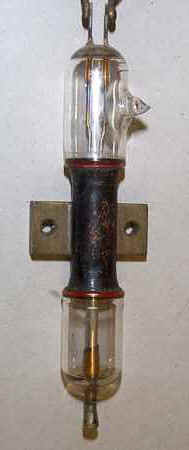
 < Triode(?) with central metal anode, connected to metal slab for
bolting to heatsink.
< Triode(?) with central metal anode, connected to metal slab for
bolting to heatsink.
>General Electric GL-860
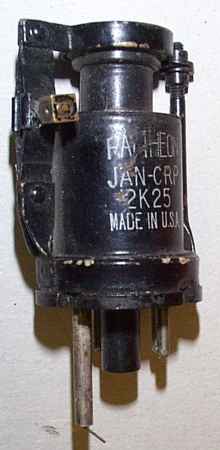
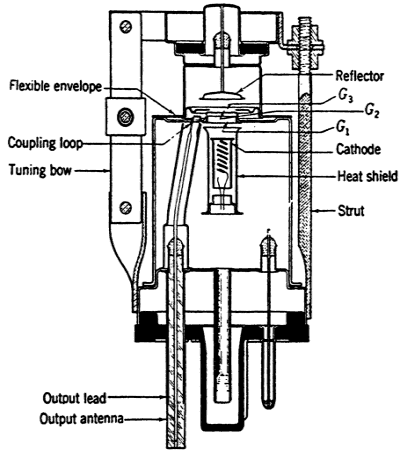 2K25 Reflex Klystron.
2K25 Reflex Klystron.
A low-power device (1.3W) used as a local oscillator for microwave communications equipment and radar receivers. Output is via a co-axial pin, and the device can be mechanically tuned with the screw on the left, which applies vertical compression to the metal envelope.
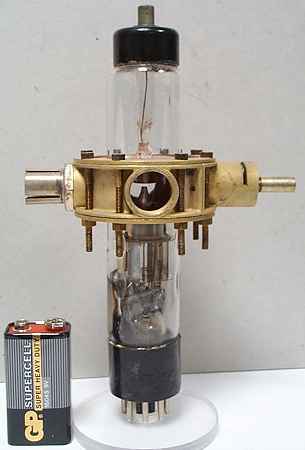
< CV67 Small Klystron
Tuning adjustment on right, output waveguide on left.
>Marconi K301 Klystron (2.5" high)

>
High-power RF triode. Marked 'KMOV7850 K 00-0436 ACT 25'
I found data on a similar looking ACT28 device, (below), described as a
'Pulse modulator' valve, rated at 11Kv,50A.
Thanks to Dave Walker at London Gatwick Airport for the following info : They
were used for the power amplifier in a bank of 4 valves in our 600Mhz radar transmitter.
You can see the venting for the forced air cooling on the valve. Their lifespan was very
short, sometimes no longer than 200 hours, and supply was limited. The radar was
decomissioned around 1990.
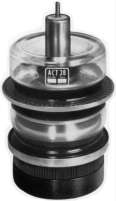
>CV2346 Klystron (3" high)
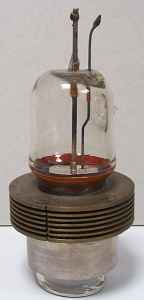
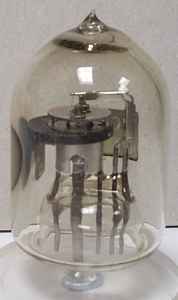
< CV1256 power device of some sort! 3¼" high excluding pins
Danial writes : The cv1256 tube is a
pulse triode similar looking to nt99 - these were used in ww2 uhf radar sets in pairs or
quads. I am a collector of old microwave tubes and would like to know if you know of any
people/ web sites/ shops etc which sell or
swap in these things.Please email if you know of
any.
> CV52 odd-looking internal construction, with unusual in-line pin configuration, one thick pin & 4 thin ones. 2" high.
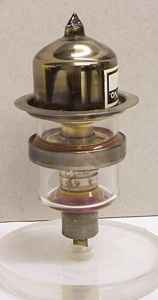
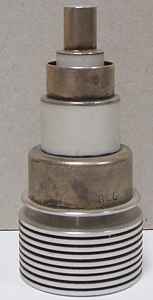 < CV397 Disc sealed high-frequency triode. David Eaton writes :
The number is the british military equivalent of the Mullard TD04-20. Heater 6.3 v
1 amp. Plate power 20 W plate volts 400 max max freq at full ratings 600 mhz. with power
output 23 watts reducing the ratings to 3.5 watts max freq 2000 mhz.
< CV397 Disc sealed high-frequency triode. David Eaton writes :
The number is the british military equivalent of the Mullard TD04-20. Heater 6.3 v
1 amp. Plate power 20 W plate volts 400 max max freq at full ratings 600 mhz. with power
output 23 watts reducing the ratings to 3.5 watts max freq 2000 mhz.
> Raytheon ML-8533 Ceramic triode, with screw-on aluminium heatsink at
base. Karl Kolbus writes : We used them back in the 1960's the the Air Force
UHF transmitter model T-217. They were used as frequency doublers/ triplers to feed the
4x150's (2) in the P/P output stage. They were tuned by the old style meshing air-gap,
segmented plate variable capacitors which were servo-rotated, depending on the
transmitting frequency selected. That's fine except to tune it, you would select the
lowest frequency, then 'home' the servo unit to bring the plates into position, bend the
appropriate plate for that freq., rotate the servo to it's operating position, and check
the output. Then repeat the process, again and again until you got your peak output. Now
repeat that whole process for all the segments on the variable; I think it was 12.
Needless to say, it took some time. Now consider this: Housed in an anodized steel box and
forced-air cooled, the circuit was so touchy that, when you screwed the cover back on and
torqued down it's 16 ! counter-sunk flathead screws, more often than not, the output would
drop from it's nominal 15 watts to almost zero. You then had to back off some of the cover
screws a little until the output came back up. But, you never knew which ones! Lots of
fun. By the way, the tube is shown upside-down. If operated in that position, it would
self-destruct. Even in the upright position you couldn't key the transmitter for longer
than 15 or 20 seconds at a time without risking damage!
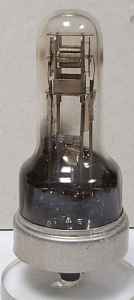
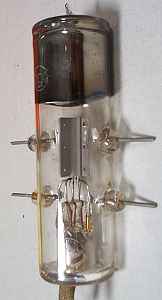
< CV79 Small magnetron
> RCA VT-228 Transmitting Triode, with side anode and grid connections
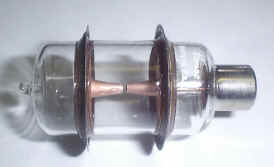 < Eimac JAN-CIM-15E
< Eimac JAN-CIM-15E
Pat Jankowiak writes : The 15E put out a 5KW pulse at 600 MHz for use in dive WWII bomber radar.
>Bomac JAN-CBNQ-721B TR Cell. Used in radar equipment to stop the high transmit power damaging the receiver.
Telefunken YH1110 travelling-wave tube. This device is a used as a microwave
power amplifier in communications applications including satellites.
EEV BS502 TR tube. Used in radar applications to protect the receiver from
the high power transmit signal.
CV16 - possibly a klystron ? Upper electrode is hollow - maybe an
entry port for a microwave signal ?
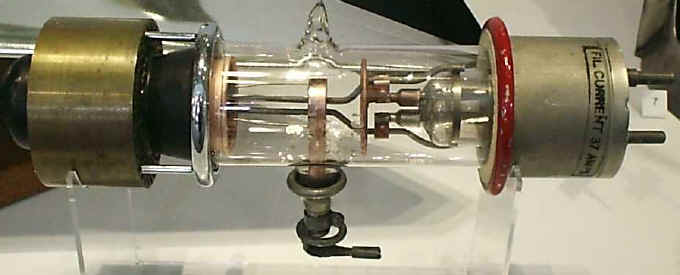 VT98A Power triode (1938) Used in 1.5 metre mobile ground radar transmitters.
This one is in the London Science Museum, but I have subsequently got my own one (marked
CV1098), which looks identical apart from not having the red colour around the base.
VT98A Power triode (1938) Used in 1.5 metre mobile ground radar transmitters.
This one is in the London Science Museum, but I have subsequently got my own one (marked
CV1098), which looks identical apart from not having the red colour around the base.

![]()